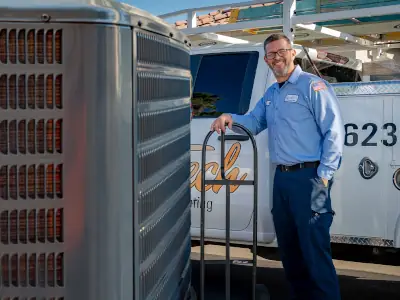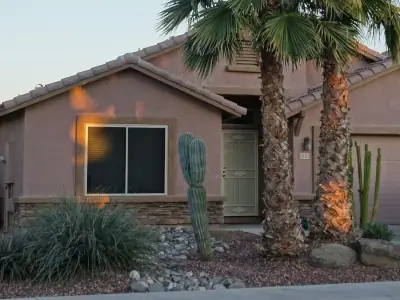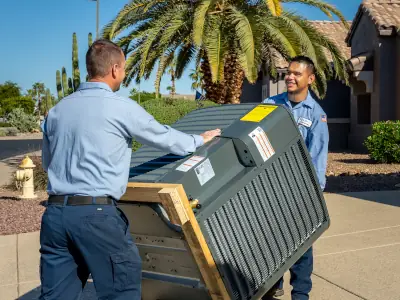Ever wondered if your AC is pulling its weight? The size of your air conditioner isn’t just a number—it’s the key to a home that feels like a refreshing oasis instead of a sticky sauna. A properly sized AC ensures cool comfort, energy efficiency, and peace of mind during those sweltering summer months.
But here’s the twist: bigger isn’t always better, and smaller isn’t always smarter. Let’s unpack air conditioner heat load, and what an undersized AC unit is.
Understanding AC Sizing
AC sizing refers to how much cooling power your unit has, measured in BTUs (British Thermal Units) or tons. The right size ensures your AC can efficiently cool your space without overworking or underperforming.
Undersized Units
When your AC is too small, it struggles to keep up, leaving you hot, sweaty, and frustrated. Here’s what you might experience:
- Constant Operation: Your AC never takes a break.
- Uneven Cooling: Some rooms stay warm while others cool down.
- High Energy Bills: Inefficient use drives up costs.
- Reduced Lifespan: Overworking shortens the system’s life.
- Humidity Issues: Poor cooling leaves moisture hanging around.
- Noisy Operation: It’s loud and always running.
Oversized Units

Think bigger is better? Not for AC units! An oversized system cools too quickly, skipping critical steps like dehumidifying, which can leave you uncomfortable in unexpected ways.
- Short Cycling: Turns on and off frequently, wasting energy.
- High Humidity: Doesn’t run long enough to dehumidify properly.
- Uneven Temperatures: Cold bursts but no lasting comfort.
- Higher Initial Costs: You’re paying more than you need to.
- Increased Wear and Tear: More frequent cycling leads to quicker breakdowns.
- Unnecessary Noise: Starts and stops create constant disruptions.
Calculating Heat Load
A heat load calculation is an assessment that determines your home’s specific cooling needs. It evaluates how heat enters and escapes your space, ensuring your AC is perfectly matched to your home’s requirements.
What Does a Heat Load Factor?
 Key structural elements like windows, doors, walls, and attic insulation greatly impact heat gain or loss. Older or poorly insulated homes allow more heat to infiltrate, requiring a larger cooling capacity, while energy-efficient homes need less cooling power to maintain comfort.
Key structural elements like windows, doors, walls, and attic insulation greatly impact heat gain or loss. Older or poorly insulated homes allow more heat to infiltrate, requiring a larger cooling capacity, while energy-efficient homes need less cooling power to maintain comfort.
The orientation of your home, sunlight exposure, and local climate play a major role. Homes facing south or west often experience higher heat gain from sunlight. Different regions are also hotter or less hot. A house in Phoenix is likely to have more cooling needs than a similar house in Flagstaff.
Occupants, appliances, and lighting all generate heat that affects your home’s cooling needs. A household with more people, frequent appliance use, or energy-intensive lighting may require a more robust AC to counteract the added heat load effectively.
Do I Need A Professional To Calculate my Heat Load?
While DIY guides exist, heat load calculations require expertise and specialized tools for accuracy. Professionals account for all variables, ensuring your system is neither overworked nor oversized, saving you money and maximizing comfort.
Signs Your Unit May Be Undersized
An undersized AC works overtime but can’t keep up, leaving you uncomfortable and your energy bills sky-high. You might notice that certain rooms stay warm, especially during peak heat, or that your unit runs constantly without providing effective cooling. Struggling with humidity control is another common sign—your home may feel sticky despite the AC working its hardest. Additionally, high energy bills and unusual wear and tear on the system often indicate it’s too small for your home’s needs.
Other clues include noisy operation or a unit that takes forever to cool down after a hot day. If these issues sound familiar, it’s worth investigating whether your system is adequately sized to handle your home’s cooling requirements.
Having Undersized Units Evaluated by a Professional.
A professional heat load assessment is essential if your home has persistent cooling issues, inconsistent temperatures, or unique features like large windows, high ceilings, or poor insulation. Call a professional when upgrading your AC, renovating, or if DIY calculations seem uncertain. However, for straightforward setups in standard-sized homes, basic tonnage guidelines may suffice—but professional guidance ensures accuracy and long-term efficiency.
How Do I Address an Undersized Unit?
You shouldn’t leave your AC to bear more load than it can handle. Whether through upgrades, supplementary solutions, or temporary fixes, you can help take some load of your AC and help restore your home comfort.
Upgrading to A Larger Unit
Upgrading to a properly sized AC is the most effective solution. Newer models offer better energy efficiency and advanced features like zoning and smart thermostats to improve cooling performance. A well-sized unit ensures consistent temperatures, lower energy bills, and longer system life.
However, upgrades come with upfront costs and may require adjustments to your home’s electrical system. To avoid installation issues, always hire qualified professionals for the job.


Supplementing A Small Unit
If replacing the entire unit isn’t feasible, supplementary cooling can help. Ductless mini-splits are an excellent choice, providing targeted cooling in specific rooms or high-demand areas. These systems are energy-efficient, easy to install, and can work alongside your existing AC to meet your home’s needs.
Keep in mind that supplementary systems may disrupt room aesthetics and add to energy consumption if overused. Plan their placement and usage carefully to avoid unnecessary costs.
Temporary Fixes
For immediate relief, portable AC units and high-powered fans can improve cooling during peak heat. Closing off unused rooms and optimizing airflow with fans can also help your AC function more effectively without additional strain.
While useful in a pinch, temporary fixes aren’t long-term solutions. They may increase energy costs, create noise, and provide only limited relief, leaving the underlying problem unresolved.
Can Insulation Help With Improperly Sized Units?
Proper insulation is a great strategy for reducing your home’s cooling demands. By minimizing heat transfer through walls, ceilings, and attics, insulation helps your AC work more efficiently, maintain consistent temperatures, and lower energy costs. It’s a simple way to maximize comfort without overburdening your cooling system.
How Do You Improve Insulation?
Start by upgrading attic insulation, as heat often escapes or enters through the roof. Choose materials like fiberglass, cellulose, or spray foam for better temperature regulation. Seal gaps around vents and other openings to minimize air leaks.
You can also improve wall insulation by injecting foam or adding batt insulation. Replacing old, drafty windows with energy-efficient ones or using weather stripping and window film further reduces heat transfer, boosting your home’s overall efficiency.

What's The Problem With An Oversized Unit?
An oversized AC cools your home too quickly, leading to short cycling. This frequent on-off operation wastes energy, fails to remove humidity effectively, and causes uneven temperatures. Over time, it increases wear and tear, shortens the unit’s lifespan, and results in higher energy bills without providing better comfort.
How Do I Know What Size of AC I Should Get?
Your HVAC company of choice will use precise heat load calculations to assess your home’s cooling needs. By analyzing factors like insulation, windows, and sunlight exposure, they recommend your ideal unit size. Their expertise ensures efficient cooling, lower energy bills, and a system that operates smoothly without the drawbacks of being oversized, or undersized.
How Do I Future-Proof My HVAC System?
Ensuring your AC is the right size is key to maintaining comfort, efficiency, and cost savings. Whether it’s upgrading, supplementing, or improving home efficiency, addressing cooling needs proactively prevents costly issues and enhances your home’s livability, even as demands change over time. Comfort starts with the right choice.
Don’t let an undersized or oversized AC compromise your comfort. Schedule a professional heat load assessment to determine your home’s needs. Explore energy-efficient upgrades or solutions tailored to your situation. Take the first step today to enjoy consistent cooling and peace of mind all year long! Take a look at our AC Installation page for more details.





